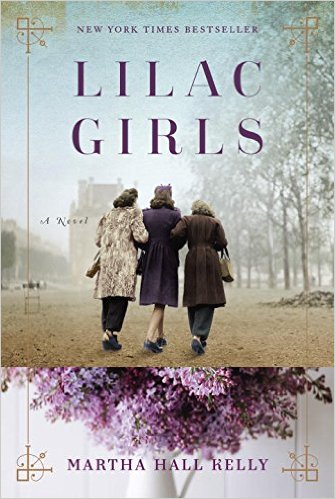 It’s hard not to be haunted by any book about the Nazi death camps. Lilac Girls, by Martha Hall Kelly, tells the story of World War II from the perspective of three women—Kasia Kusmerick, a Polish teenager who becomes a political prisoner in Ravensbrück because she helps the Polish resistance, Herta Oberheuser, a Nazi doctor at Ravensbrück who engages in medical experiments on the prisoners, and Caroline Ferriday, a New York socialite with a long history of aiding French refugees who helps the Ravensbrück survivors after the war is over.
It’s hard not to be haunted by any book about the Nazi death camps. Lilac Girls, by Martha Hall Kelly, tells the story of World War II from the perspective of three women—Kasia Kusmerick, a Polish teenager who becomes a political prisoner in Ravensbrück because she helps the Polish resistance, Herta Oberheuser, a Nazi doctor at Ravensbrück who engages in medical experiments on the prisoners, and Caroline Ferriday, a New York socialite with a long history of aiding French refugees who helps the Ravensbrück survivors after the war is over.
One fascinating aspect of the book for me was that Herta Oberheuser and Caroline Ferriday were real people, though author Martha Kelly clearly stated in her author’s note that she fictionalized aspects of their lives. By contrast, Kasia Kusmerick is a purely fictional character, and Kasia and her family are used to depict the plight of the Ravensbrück prisoners.
Most of us have read about the death camps and medical experiments done on internees in the camp. Still, this book’s gruesome descriptions of the conditions in Ravensbrück and of the operations and deliberate injuries inflicted on the prisoners are heart-wrenching and nauseating. The camp experiences of Kasia and her mother and sister provide the emotional core of the novel.
Just when the reader is overcome by the horror of how the prisoners are treated, Kelly shifts to Caroline Ferriday’s world of New York socialites and their cattiness to each other as they raise money to aid European refuges. Or Kelly switches to Herta Oberheuser’s perspective—that of a female doctor, a German patriot, who has to put up with male chauvinism and the politics among the medical staff while doing her job (however ugly that job is).
The three points of view do provide an interesting composite of World War II that is different than most novels. All the Light We Cannot See also focuses on both the French and German perspectives, but the young German soldier in that book is a much more sympathetic character than Helga Oberheuser. In Lilac Girls, while we might understand Helga’s perspective, we cannot really sympathize.
SPOILER ALERT: DO NOT READ FURTHER IF YOU DON’T WANT SPOILERS
The novel was a little uneven in places. Part 1 of the book—through the war years—dealt with all three women. But Parts 2 and 3 mostly ignored Herta. I wondered why Kelly even gave Herta a point of view in the novel, only to abandon her later in the book. There was some attempt to humanize Herta in Part 1, to explain how her Germanic pride and need to provide for her family financially drew her into conducting the experiments.
The novel could have been richer if it had dealt more with the aftermath of the war on Herta, rather than dropping her as a character, other than as a means for Kasia to demonstrate how she conquered (or at least stilled) the impact of Ravensbrück and the physical deformities the experiments left her with.
I was also troubled to find out how much fictionalizing Kelly did in creating the Caroline Ferriday character. Ms. Ferriday in reality was an admirable woman. Why did Kelly think it helped her novel to give Caroline a fictional romance with a married man?
As a writer of historical fiction myself, I found the liberties that Kelly took with real characters disconcerting. I have included historical persons in my books, but I have not built my novels around them, nor have I given them point of view roles. Many authors walk the line between biography and fiction well, and Kelly has told a good story and been upfront about the embellishments she added to Caroline Ferriday’s life. But I would have preferred a novel that stuck closer to the facts with a primary historical character such as Ferriday.
The description of the novel says that the three characters are set on a “collision course” by the events at Ravensbrück. In fact, Caroline never meets Helga. Kasia interacts with both of them, and although the novel begins with Caroline, it is really Kasia’s story.
Still, Lilac Girls is haunting because it covers haunting events in a well-written and realistic (if not historical) story. This novel isn’t of the caliber of All the Light We Cannot See or The Nightingale, but it is a good novel, a solid debut from Ms. Kelly, and I would like to read more of her work.
When have you wondered about what is fact and what is fiction in a novel about a real person?
